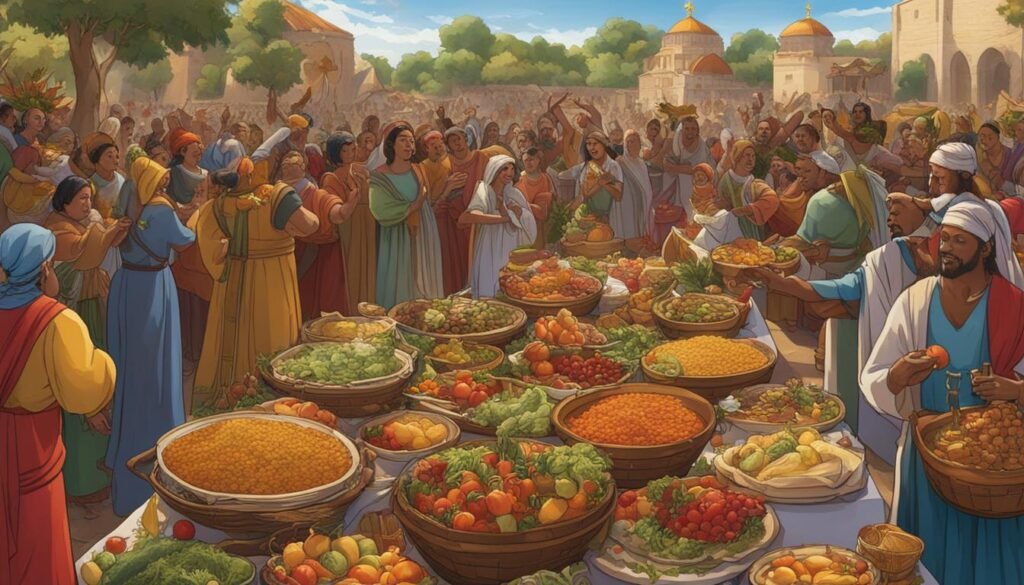The biblical tithing system, as described in the Old Testament, consists of three distinct types of tithes. Understanding these tithes is crucial for comprehending the ancient practice of giving in the biblical context.
Key Takeaways:
- The biblical tithing system encompasses three different types of tithes.
- The Levitical tithe was given to the Levites and priests for their service in the temple.
- The Feast tithe supported religious festivals and trips to Jerusalem.
- The Poor tithe was designated for the support of the needy, including widows, orphans, and foreigners.
The Levitical Tithe
The Levitical tithe was a sacred practice in the biblical tithing system. It was consecrated to God and specifically designated for the support of the priests and Levites who served in the temple. The Levites were chosen by God to be set apart for His service and did not own any land or have a traditional means of livelihood. Therefore, the Levitical tithe was their provision and sustenance.
Refusing to pay the Levitical tithe was considered stealing from God Himself, as the people had entered into a covenant with Him to faithfully give a portion of their income. In Malachi 3:8-10, God rebukes the people for robbing Him by withholding their tithes and calls them to return to Him in obedience. This demonstrates the seriousness with which God views the Levitical tithe and the importance of honoring our commitments to Him.
“Will a man rob God? Yet you are robbing Me! But you say, ‘How have we robbed You?’ In tithes and offerings. You are cursed with a curse, for you are robbing Me, the whole nation of you! Bring the whole tithe into the storehouse, so that there may be food in My house, and test Me now in this,” says the Lord of hosts, “if I will not open for you the windows of heaven and pour out for you a blessing until it overflows.
The Levitical tithe serves as a reminder of the importance of consecrating a portion of our income to God and supporting those who are called to serve Him. Under the new covenant of Christ, believers are still called to give faithfully and generously, recognizing that all that we have belongs to Him. By honoring the Levitical tithe, we participate in God’s work and demonstrate our trust in His provision for our lives.

| Levitical Tithe | Modern Giving |
|---|---|
| Consecrated to God | Recognizing God’s ownership of all resources |
| Support for priests and Levites | Support for pastors, missionaries, and ministries |
| Contract with God | Expression of faith and trust in God’s provision |
| Required by law | Voluntary act of worship and gratitude |
The Feast Tithe
The Feast tithe was an integral part of the biblical tithing system and played a significant role in providing for religious festivals and trips to Jerusalem. This tithe served as a means of ensuring that the Hebrew people could participate in the various religious celebrations outlined in the Old Testament. It was specifically set aside to fund the expenses of the journey and the festivities that took place in the presence of the Lord.
The Feast tithe acted as a form of savings for the Hebrew community, as they were required to travel to Jerusalem for specific occasions. By setting aside a portion of their income, the people could accumulate the necessary funds to cover the expenses associated with these trips. This financial provision allowed the Hebrews to fully engage in the religious festivals and engage in communal worship in the presence of their God.
Examples of Religious Festivals
- Passover
- Pentecost
- Feast of Tabernacles
These religious festivals provided opportunities for the Hebrews to connect with God, renew their faith, and celebrate together as a community. The Feast tithe ensured that no one was excluded from these important events due to financial limitations, emphasizing the inclusive nature of the biblical tithing system.

The Feast tithe, along with the other types of tithes, demonstrates the importance of both spiritual and physical provisions in the Old Testament. It highlights the significance of setting aside resources for religious purposes and ensuring that everyone in the community has the opportunity to participate in the worship and festivities in Jerusalem.
The Poor Tithe
The Poor tithe, a significant component of the biblical tithing system, played a crucial role in providing support for the needy. This tithe was a community project where everyone contributed to ensure the well-being of the less fortunate. The produce collected through this tithe was stored in the towns and then distributed among various groups, including the Levites, sojourners, orphans, and widows.
The primary objective of the Poor tithe was to ensure that those in need had enough to eat and were satisfied. It highlighted the importance of compassion and caring for one’s neighbors. By actively participating in this tithe, the Hebrew people demonstrated their commitment to building a strong and supportive community, where no one was left behind.
This community-oriented approach towards supporting the poor emphasizes the broader concept of giving in the Old Testament. It served as a reminder of the shared responsibility to care for those who were less fortunate. Through the Poor tithe, the Hebrew people recognized the value of unity and compassion, fostering a spirit of generosity and kindness within their society.
FAQ
How many types of tithes are there in the Bible?
There are three types of tithes mentioned in the Old Testament.
What is the Levitical tithe?
The Levitical tithe was the most important of the three tithes. It was consecrated to God and given to the Levites and priests for their service in the temple.
What is the Feast tithe?
The Feast tithe was set aside to fund trips to Jerusalem and participate in religious festivals. It served as a type of savings for the Hebrew people and provided for the expenses of the journey and festivities in the presence of the Lord.
What is the Poor tithe?
The Poor tithe was given every third year and designated for the support of the poor. It was a community project in which everyone contributed, and the produce was stored in the towns for distribution. This tithe supported the Levites, sojourners, orphans, and widows.

I’m Benjamin, a passionate spiritual seeker and creator of Verses and Prayers. Alongside my girlfriend Emma and our pet lizard Mulle, I cherish family life, enjoy exploring new places, and am deeply involved in my church community. My love for reading and singing biblical verses inspires every aspect of my journey.

